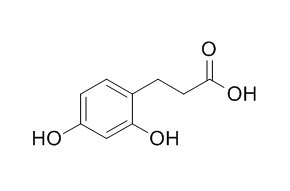3-(2,4-Dihydroxyphenyl)propionic acid
3-(2,4-Dihydroxyphenyl)propionic acid and l-ascorbic acid show tyrosinase inhibition activity, a synergistic effect on tyrosinase inhibition was observed when the two compounds were mixed.
Inquire / Order:
manager@chemfaces.com
Technical Inquiries:
service@chemfaces.com
Tel:
+86-27-84237783
Fax:
+86-27-84254680
Address:
1 Building, No. 83, CheCheng Rd., Wuhan Economic and Technological Development Zone, Wuhan, Hubei 430056, PRC
Providing storage is as stated on the product vial and the vial is kept tightly sealed, the product can be stored for up to
24 months(2-8C).
Wherever possible, you should prepare and use solutions on the same day. However, if you need to make up stock solutions in advance, we recommend that you store the solution as aliquots in tightly sealed vials at -20C. Generally, these will be useable for up to two weeks. Before use, and prior to opening the vial we recommend that you allow your product to equilibrate to room temperature for at least 1 hour.
Need more advice on solubility, usage and handling? Please email to: service@chemfaces.com
The packaging of the product may have turned upside down during transportation, resulting in the natural compounds adhering to the neck or cap of the vial. take the vial out of its packaging and gently shake to let the compounds fall to the bottom of the vial. for liquid products, centrifuge at 200-500 RPM to gather the liquid at the bottom of the vial. try to avoid loss or contamination during handling.
J Sci Food Agric.2017, 97(5):1656-1662
Environ Toxicol.2019, 34(12):1354-1362
University of Manitoba2023, 37433.
Oxid Med Cell Longev2020, 12
Molecules.2022, 27(13):4227.
Phytother Res.2019, 33(7):1784-1793
Nat Plants.2016, 3:16205
Anal Bioanal Chem.2023, 415(9):1641-1655.
Food Chem.2018, 262:78-85
Front Microbiol.2024, 15:1429027.
Related and Featured Products
Postharvest Biology and Technology, 2006,39(3):272-7.
Prevention of Agaricus bisporus postharvest browning with tyrosinase inhibitors[Reference:
WebLink]
Postharvest browning of Agaricus bisporus mushrooms is a severe problem that reduces the shelf life of harvested mushrooms. Mushroom browning occurs mainly as a result of tyrosinase activity, an enzyme belonging to the polyphenol oxidase (PPO) family and known to be a key enzyme in melanin biosynthesis.
METHODS AND RESULTS:
An ethanolic extract from licorice roots (Glycyrrhiza glabra) and [3-(2,4-Dihydroxyphenyl)propionic acid] (DPPacid) isolated from fig leaves and fruit have been shown to inhibit tyrosinase activity. Adding these inhibitors to sliced mushrooms had a very strong inhibitory effect on browning, but pre-storage immersion of intact mushroom in the licorice extract did not prevent browning after 8 days storage at 4 °C. By contrast, treatment with DPPacid at 1 μg/mL reduced browning by half. Measurement of inhibitor uptake by mass spectra (MS) and assay of tyrosinase activity indicated that penetration into the mushroom tissue was inadequate for tyrosinase inhibition. Moreover, DPPacid was found to be unstable in the mushroom tissue and within a short time it was, presumably, metabolised.
Z Naturforsch C. 2017 Mar 1;72(3-4):119-121.
The evaluation of the synergistic effect of 3-(2,4-dihydroxyphenyl)propionic acid and l-ascorbic acid on tyrosinase inhibition.[Pubmed:
27442367 ]
3-(2,4-Dihydroxyphenyl)propionic acid (DDPA) and l-ascorbic acid (vitamin C) show tyrosinase inhibition activity. A synergistic effect on tyrosinase inhibition was observed when the two compounds were mixed. The effect significantly decreased the IC50 value of both compounds.



